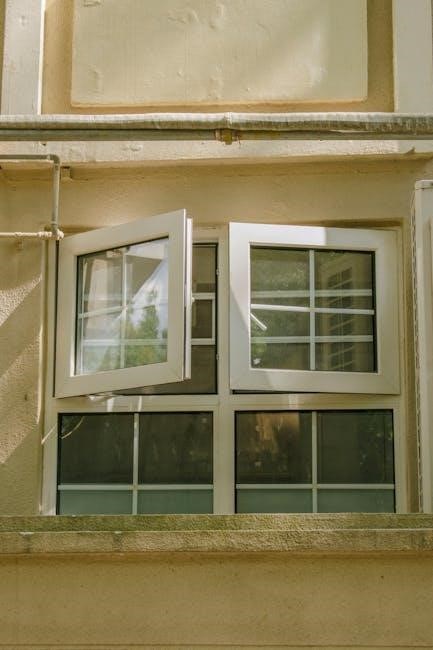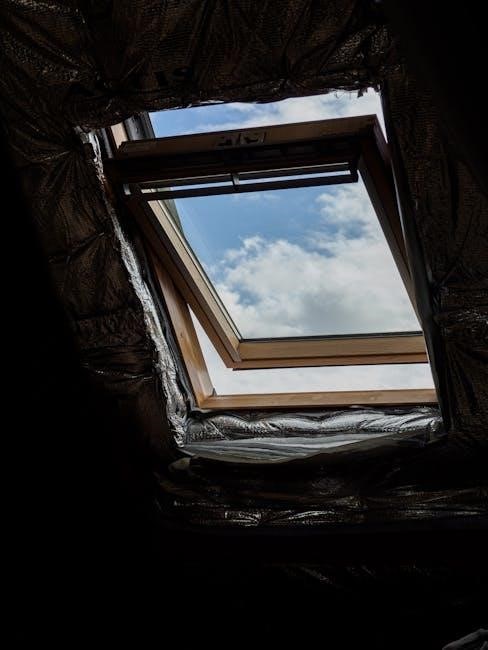The NC Building Code establishes standards for insulation‚ ensuring energy efficiency‚ safety‚ and structural integrity in buildings‚ promoting sustainable practices and reducing energy costs effectively.
1.1 Overview of the North Carolina Building Code
The North Carolina Building Code is a comprehensive set of regulations designed to ensure the safety‚ accessibility‚ and energy efficiency of buildings across the state. Based on the International Building Code and the International Energy Conservation Code‚ it provides detailed standards for construction‚ including structural integrity‚ fire safety‚ and environmental sustainability. The code applies to both residential and commercial buildings‚ outlining requirements for materials‚ design‚ and installation processes. Regular updates to the code reflect advancements in construction practices‚ technological innovations‚ and evolving energy efficiency standards. Compliance with the NC Building Code is mandatory for all new construction projects‚ ensuring consistency and quality while protecting public health‚ safety‚ and welfare. It also plays a crucial role in reducing energy consumption and environmental impact.
1.2 Importance of Insulation in Building Construction
Insulation plays a vital role in building construction by enhancing energy efficiency‚ reducing energy costs‚ and improving indoor air quality. It acts as a thermal barrier‚ minimizing heat loss during winter and heat gain during summer‚ thereby lowering heating and cooling demands. Proper insulation also helps in reducing noise pollution‚ creating a more comfortable living or working environment. Additionally‚ it prevents moisture accumulation‚ which can lead to mold growth and structural damage. Insulation is critical for meeting energy efficiency standards outlined in the NC Building Code‚ ensuring buildings are environmentally sustainable and cost-effective. By regulating temperature and humidity‚ insulation contributes to the overall durability of a building and protects its occupants from extreme weather conditions. Its importance is further emphasized in the NC Building Code‚ which mandates specific insulation requirements to ensure public safety‚ energy conservation‚ and environmental protection.

Key Insulation Requirements in the NC Building Code
The NC Building Code sets specific insulation standards to reduce energy consumption and ensure thermal performance in buildings‚ covering requirements for walls‚ ceilings‚ and foundations while promoting safety and efficiency.
2.1 Minimum Insulation Standards for Residential Buildings
The NC Building Code outlines specific insulation requirements for residential buildings to ensure energy efficiency and thermal performance. These standards are based on climate zones‚ with North Carolina falling primarily into Zone 3 and parts of Zone 4. For walls‚ the code mandates a minimum R-value of R-13 for exterior walls and R-19 for cavity insulation. Ceilings must meet at least R-30 for uninsulated attics and R-38 for insulated attics. Floors‚ particularly those over unheated spaces like crawl spaces‚ require R-25 insulation. Additionally‚ the code emphasizes proper installation techniques and material quality to maintain thermal resistance and prevent heat loss; These requirements aim to reduce energy consumption‚ lower utility costs‚ and promote environmentally friendly building practices. Compliance with these standards is essential for both new constructions and renovations to ensure long-term efficiency and comfort in residential settings.
2.2 Insulation Requirements for Commercial Buildings
The NC Building Code sets forth specific insulation standards for commercial buildings to enhance energy efficiency and reduce operational costs. These requirements vary based on building type‚ climate zones‚ and structural components. For commercial constructions‚ the code mandates higher insulation levels compared to residential buildings. Walls must meet a minimum R-value of R-13 for exterior walls and R-19 for continuous insulation. Ceilings require R-30 for insulated roof assemblies‚ while floors over unheated spaces must achieve R-25. Additionally‚ the code emphasizes the use of approved insulation materials‚ such as fiberglass batts‚ rigid foam boards‚ and spray foam‚ ensuring they meet thermal performance standards. Proper installation is critical to maintain the integrity of the insulation system. Compliance with these requirements helps commercial buildings achieve energy efficiency‚ reduce energy consumption‚ and contribute to environmental sustainability while meeting safety and structural integrity standards.

Insulation Requirements for Specific Building Components
The NC Building Code specifies insulation requirements for walls‚ ceilings‚ floors‚ and foundations‚ ensuring thermal performance and energy efficiency in each building component‚ aligned with climate zone standards.
3.1 Wall Insulation Requirements
The NC Building Code outlines specific insulation requirements for walls to ensure energy efficiency and thermal performance. Exterior walls must meet minimum R-value requirements‚ which vary based on climate zones. In North Carolina‚ which spans Climate Zones 3 and 4‚ exterior walls typically require R-13 to R-20 insulation‚ depending on the construction type. Continuous insulation is mandated for commercial buildings to reduce thermal bridging. Insulation materials must be approved‚ such as fiberglass batts‚ spray foam‚ or rigid foam board. Proper installation is critical to avoid gaps or compression‚ ensuring the insulation performs as intended. These requirements help reduce heat loss‚ lower energy consumption‚ and contribute to building durability. Compliance with these standards is enforced through inspections‚ ensuring buildings meet both safety and energy efficiency goals.
3.2 Ceiling and Roof Insulation Requirements
The NC Building Code specifies insulation requirements for ceilings and roofs to enhance energy efficiency and thermal performance. Residential buildings must meet minimum R-value standards‚ typically R-38 for ceilings and R-20 for roofs‚ depending on the climate zone. Commercial buildings may require higher R-values to meet energy efficiency standards. Insulation materials must be approved‚ such as spray foam‚ fiberglass batts‚ or rigid foam board. Proper installation is crucial to prevent gaps and ensure continuous coverage. These requirements help reduce heat loss‚ lower energy consumption‚ and improve indoor comfort. Compliance is verified through inspections‚ ensuring buildings meet both energy efficiency and safety standards. Adherence to these guidelines supports overall energy code compliance and contributes to sustainable building practices in North Carolina. Proper insulation also helps protect against moisture damage and extends the lifespan of the building envelope.
3.3 Floor Insulation Requirements
The NC Building Code outlines specific requirements for floor insulation to ensure energy efficiency and thermal performance. Residential buildings must insulate floors above unheated spaces‚ such as crawlspaces or garages‚ with a minimum R-value of R-19 in climate zones 3 and 4. For commercial buildings‚ the requirements may vary based on the building type and use. Insulation materials like rigid foam board or fiberglass batts are commonly used‚ and they must be installed correctly to prevent gaps and ensure continuity. Proper insulation helps reduce heat loss‚ lower energy bills‚ and prevent moisture damage. Additionally‚ slab-on-grade floors may require insulation around the perimeter to meet energy efficiency standards. Compliance with these requirements is verified through inspections‚ ensuring that floors meet both energy efficiency and safety standards. Proper floor insulation also contributes to a more comfortable indoor environment and reduces the risk of structural issues over time.
3.4 Foundation Insulation Requirements
The NC Building Code specifies detailed requirements for foundation insulation to enhance energy efficiency and structural integrity. Residential foundations must meet minimum R-value standards‚ typically R-10 for uninsulated crawlspaces and R-15 for insulated ones. Insulation materials like rigid foam board or spray foam are commonly used. Continuous insulation around foundation walls and under slab-on-grade floors is mandatory to prevent heat loss and moisture infiltration. Proper installation ensures thermal performance and prevents structural damage from freezing temperatures. Insulation must extend below the frost penetration depth to maintain effectiveness. Additionally‚ crawlspaces may require insulation on the walls or ceiling‚ depending on the building’s design. Compliance with these requirements is verified during inspections to ensure energy efficiency and long-term durability. Adhering to these standards helps reduce energy consumption and enhances the overall comfort and safety of the building. Proper foundation insulation is crucial for meeting the NC Building Code’s energy efficiency goals.

Compliance and Enforcement of Insulation Requirements
The NC Building Code ensures compliance through routine inspections‚ enforcing penalties for non-compliance and requiring proper insulation documentation to meet energy efficiency standards effectively and consistently.
4.1 Inspection Processes for Insulation Compliance
The NC Building Code mandates rigorous inspection processes to ensure insulation compliance. Certified inspectors conduct on-site evaluations‚ verifying that insulation materials and installations meet specified standards. Inspections typically occur at critical stages‚ such as during construction and before occupancy. Inspectors review thermal performance‚ R-values‚ and installation quality to guarantee adherence to energy efficiency and safety requirements. Documentation‚ including material certifications and installation records‚ must be provided for approval. Any deviations from the code result in corrective actions‚ potentially delaying project completion. These processes are essential to maintaining building integrity‚ reducing energy consumption‚ and ensuring compliance with state and local regulations. Proper inspections safeguard occupants while promoting sustainable building practices across North Carolina.
4.2 Penalties for Non-Compliance
Failure to comply with the NC Building Code insulation requirements can result in significant penalties. These may include monetary fines‚ stop-work orders‚ or even the revocation of building permits. Inspections revealing non-compliant insulation installations can lead to project delays or the requirement to redo work at the owner’s expense. Repeat violations may result in increased penalties or legal action. Additionally‚ non-compliance can jeopardize certification and occupancy approvals‚ preventing the use of the building until issues are resolved. Authorities may also impose penalties for energy code violations‚ which could include higher fines or mandatory upgrades. These measures ensure accountability and adherence to safety‚ energy efficiency‚ and structural standards outlined in the NC Building Code.

Materials and Installation Guidelines

The NC Building Code specifies approved insulation materials and proper installation methods to ensure safety‚ efficiency‚ and compliance with energy standards.

5.1 Approved Insulation Materials
The NC Building Code specifies various insulation materials that meet energy efficiency and safety standards. Commonly approved materials include fiberglass batts‚ cellulose‚ rigid foam boards‚ and spray foam insulation. These materials are chosen for their thermal performance‚ durability‚ and ability to meet R-value requirements. The code also considers fire resistance and environmental impact‚ ensuring materials are safe and sustainable. Proper certification and compliance with ASTM standards are mandatory for all insulation products. Additionally‚ the code addresses moisture-resistant insulation for areas prone to dampness‚ such as basements and crawlspaces. By adhering to these guidelines‚ builders ensure energy efficiency‚ structural integrity‚ and long-term performance of insulation systems;
5.2 Proper Installation Techniques
Proper insulation installation is crucial for meeting NC Building Code requirements. Techniques must ensure a tight fit‚ minimal gaps‚ and adequate coverage in walls‚ ceilings‚ and foundations. Installers should follow manufacturer guidelines and code specifications to avoid common errors like improper cutting or insufficient material. The code emphasizes the importance of sealing air leaks and ensuring continuous insulation in critical areas. Moisture barriers and vapor retarders must be correctly installed to prevent damage and maintain thermal performance. Additionally‚ installers should be trained and certified to handle specific materials and applications. Regular inspections are recommended to verify compliance and address any issues promptly. Proper installation not only enhances energy efficiency but also ensures the longevity and safety of the building structure. Adherence to these techniques is essential for achieving the desired R-values and maintaining code compliance.

Energy Efficiency and Insulation
Insulation plays a critical role in energy efficiency by reducing heat loss and gain‚ aligning with the NC Building Code’s goals to lower energy consumption and costs effectively.
6;1 Role of Insulation in Energy Efficiency
Insulation is a cornerstone of energy efficiency‚ significantly reducing heat transfer between indoors and outdoors. By minimizing thermal losses‚ it lowers heating and cooling demands‚ reducing energy consumption and costs. Proper insulation ensures consistent indoor temperatures‚ enhancing comfort and reducing the strain on HVAC systems. It also helps buildings meet energy codes and contributes to environmental sustainability by lowering greenhouse gas emissions. Additionally‚ insulation protects against temperature extremes and moisture issues‚ ensuring structural durability. The NC Building Code emphasizes insulation’s role in creating energy-efficient buildings‚ promoting long-term savings for homeowners and businesses while supporting broader energy conservation goals.
6.2 Energy Code Compliance
Energy code compliance ensures buildings meet established energy efficiency standards‚ reducing energy consumption and costs. The NC Building Code outlines specific insulation requirements to align with these goals. Compliance involves verifying insulation levels‚ HVAC system efficiency‚ and building envelope performance through inspections and documentation. Proper insulation installation is critical for meeting these standards. Buildings that comply experience lower energy use‚ reduced utility bills‚ and enhanced environmental sustainability. Compliance also supports broader energy conservation initiatives‚ promoting a greener future. By adhering to these codes‚ property owners contribute to energy efficiency while benefiting from cost savings and improved building performance.
Climate Zones and Insulation Requirements
The NC Building Code adapts insulation requirements based on climate zones‚ ensuring energy efficiency and comfort. North Carolina spans multiple zones‚ requiring tailored insulation strategies to match local conditions effectively.
7.1 Insulation Requirements for Different Climate Zones in NC
The NC Building Code divides the state into specific climate zones‚ each with unique insulation requirements. These zones are determined by factors like temperature‚ humidity‚ and regional weather patterns. In North Carolina‚ the primary climate zones are influenced by its location in the southeastern United States‚ with varying levels of heating and cooling demands. For example‚ northern regions may require higher R-values for insulation in walls‚ ceilings‚ and floors compared to southern areas. The code specifies minimum insulation standards for residential and commercial buildings in each zone to ensure energy efficiency and comfort. Proper insulation helps reduce energy consumption‚ lowers utility costs‚ and aligns with the state’s energy efficiency goals. Builders must consult the NC Building Code to determine the exact requirements for their specific region‚ ensuring compliance and optimal building performance. This tailored approach addresses the diverse climatic conditions across the state effectively.
7.2 Adjustments for Local Climate Conditions
The NC Building Code allows for adjustments in insulation requirements based on local climate conditions‚ ensuring buildings are optimized for their specific environments. For instance‚ coastal regions with high humidity may require different insulation materials to mitigate moisture issues‚ while mountainous areas with colder temperatures might need enhanced thermal performance. These adjustments ensure energy efficiency‚ comfort‚ and structural durability. Local building authorities may enforce additional measures tailored to regional weather patterns‚ such as increased insulation in areas prone to extreme cold or heat. Builders must consider these factors to meet code standards and adapt designs to local conditions‚ balancing energy savings with practical construction needs. This flexibility enables compliance while addressing the unique challenges of North Carolina’s diverse climate regions effectively. Proper adjustments ensure buildings perform well under varying environmental stresses‚ maintaining occupant comfort and reducing long-term maintenance costs.

Special Considerations
The NC Building Code includes special considerations for historic buildings and high-performance structures‚ addressing unique insulation needs while maintaining safety and energy efficiency standards effectively.
8.1 Insulation Requirements for Historic Buildings
Historic buildings in North Carolina are subject to unique insulation requirements that balance preservation with modern energy efficiency standards. The NC Building Code recognizes the importance of maintaining the architectural integrity of these structures while ensuring safety and energy performance. Insulation materials and installation methods must be compatible with the building’s original design and materials‚ often requiring custom solutions. Local historic preservation commissions may grant exceptions to standard insulation requirements if they compromise the building’s historic character. However‚ any modifications must still meet minimum safety and energy efficiency thresholds. This approach ensures that historic buildings remain functional and energy-efficient without losing their cultural significance. Proper documentation and approval from relevant authorities are typically required for such projects.
8.2 Insulation Requirements for High-Performance Buildings
High-performance buildings in North Carolina are held to stringent insulation standards to maximize energy efficiency and reduce environmental impact. The NC Building Code mandates higher R-values for walls‚ ceilings‚ and foundations compared to standard buildings. These structures often require continuous insulation in exterior walls to minimize thermal bridging. Additionally‚ insulation materials must meet specific performance criteria‚ such as high recycled content or low VOC emissions‚ to align with sustainability goals. Advanced insulation techniques‚ like spray foam or rigid foam board‚ are commonly specified. Windows and doors must also meet rigorous U-factor and SHGC requirements to ensure minimal heat transfer. These measures aim to create buildings that not only meet but exceed energy efficiency benchmarks‚ supporting the state’s broader sustainability initiatives while maintaining occupant comfort and reducing long-term operational costs.
Resources and References
Access the official NC Building Code Insulation Requirements PDF through the North Carolina Department of Insurance website for detailed guidelines and compliance standards.

9.1 Accessing the NC Building Code Insulation Requirements PDF
The NC Building Code Insulation Requirements PDF is available on the North Carolina Department of Insurance website. To access it‚ visit the official portal and navigate to the building codes section. Use the search function to locate the document‚ which outlines specific insulation standards‚ compliance guidelines‚ and updates. The PDF provides detailed information on energy efficiency‚ material specifications‚ and installation best practices. It also includes references to state and local amendments‚ ensuring builders and homeowners meet all regulatory requirements. For accuracy‚ always refer to the most recent edition‚ as codes are periodically updated. Additional resources‚ such as FAQs and update summaries‚ are often provided alongside the PDF for easier understanding and implementation.
9.2 Additional Resources for Builders and Homeowners
Beyond the NC Building Code Insulation Requirements PDF‚ builders and homeowners can access additional resources to ensure compliance and optimal insulation practices. The North Carolina Department of Insurance offers workshops and webinars that provide in-depth training on insulation standards; Local building departments often supply checklists and guidelines tailored to specific regions. Trade organizations‚ such as the North Carolina Home Builders Association‚ publish case studies and best practices. Energy efficiency programs‚ like those from Duke Energy and Dominion Energy‚ offer rebates and technical assistance for insulation upgrades. Additionally‚ non-profit organizations like the North Carolina Building Performance Association provide resources on sustainable building practices. These resources help stakeholders stay informed and implement insulation requirements effectively while promoting energy efficiency and cost savings.